#doomsday seed vault
Explore tagged Tumblr posts
Text

Svalbard Global Seed Vault
The Svalbard Global Seed Vault is a secure seed bank located on the Norwegian island of Spitsbergen, near Longyearbyen. It was established in 2008 as a global backup facility to preserve and protect the world's crop diversity in case of regional or global catastrophes.
Often referred to as the "Doomsday Vault," the seed vault is built into a mountainside and designed to withstand natural and human-made disasters, including earthquakes and nuclear war. It is situated in the permafrost, providing natural cooling and preserving the seeds at a constant low temperature.
The purpose of the seed vault is to safeguard the world's agricultural heritage and ensure the availability of diverse plant genetic resources for future generations. The vault acts as a repository, storing duplicate seed samples from gene banks around the world. These samples represent a wide range of important food crops and plant species.
The seed vault currently holds over one million different seed samples, with the capacity to store up to 4.5 million samples. It serves as a long-term insurance policy for global food security, as it allows for the reestablishment of crops in the event of a major regional or global catastrophe.
The Svalbard Global Seed Vault is an important international initiative, symbolizing the collective efforts to safeguard the world's agricultural heritage and ensure the resilience of food systems.
Read more
#wikipedia#weird facts#weird history#strange facts#strange history#random fact#weird wikipedia#wikiweird#Svalbard Global Seed Vault#doomsday#bunker
50 notes
·
View notes
Text
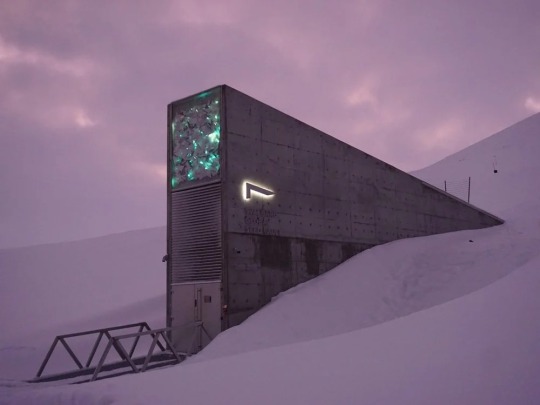
The Svalbard Global Seed Vault is located in the Norwegian Arctic on the remote island of Spitsbergen. Shaliz Barzani/Crop Trust
Take a Virtual Tour of the ‘Doomsday’ Seed Vault! The Impressive Depository Carefully Preserves Over One Million Seed Samples In Its Arctic Location
— Teresa Nowakowski, Staff Contributor | March 16, 2023 | Smithsonian Mag
In the frigid Norwegian Arctic, a gray wedge-shaped building protrudes from a mountain. Snow blows across the small metal bridge that leads to its entrance, above which a pattern of steel, mirrors and prisms reflect a ghostly green light. Large letters on the building’s side hint at the precious collection that’s held within, declaring that here is the entrance to the “Svalbard Global Seed Vault.”
Only a handful of people are allowed inside the vault, and its five metal doors are only opened a few times each year for new entries of seeds. But now, in honor of its 15th anniversary, you can catch a rare glimpse of the vault’s interior through a virtual tour.
Carved into Plateau Mountain on the Norwegian island of Spitsbergen, it holds more than 1.2 million seed samples from almost every country in the world, including recent first-time depositors Albania, Croatia, North Macedonia and Benin. Meant to protect crop biodiversity in case of localized catastrophe, this curious depository is often referred to as the “doomsday seed vault.”
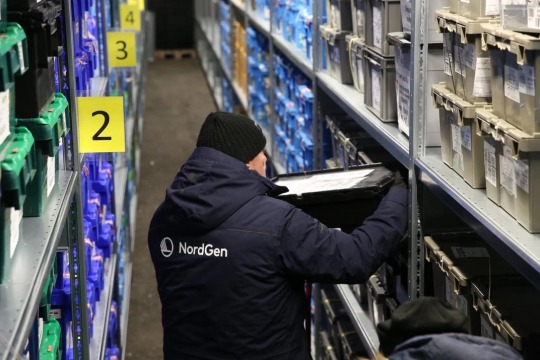
A member of NordGen, the gene bank of the Nordic countries, places a box of seeds in one of the vault chambers. Luis Salazar/Crop Trust
“From here in Svalbard, the world looks different. This seed vault represents hope, unity and security,” says Stefan Schmitz, executive director of the Crop Trust, a co-manager of the vault, in a press release. “In a world where the climate crisis, biodiversity loss, natural catastrophes and conflicts increasingly destabilize our food systems, it has never been more important to prioritize safeguarding these tiny seeds that hold so much potential to adapt our future food to such global threats.”
The contents of this doomsday vault are effectively backup storage for a global network of more than 1,700 smaller vaults called gene banks. Countries deposit copies of the seeds they hold in their own banks, and the Svalbard facility keeps them safe. This year, new seed deposits of wild strawberries, wheat, maize and rice have joined the ranks of other preserved plants. An organization from North Macedonia deposited seeds from an ajvarka red pepper variety used to make a popular traditional relish.
The seeds remain the property of the depositing country, to be withdrawn in the event their own stockpile is compromised. In 2015, for example, seeds from the vault were used to restart the International Center for Agricultural Research in the Dry Areas after its Aleppo seed bank had to be abandoned during the Syrian civil war.
To preserve its contents, the Arctic vault is protected by almost 400 feet of rock at its deepest point. Even virtually, its floor-to-ceiling shelves with the space for thousands of seed boxes are an impressive sight to behold.
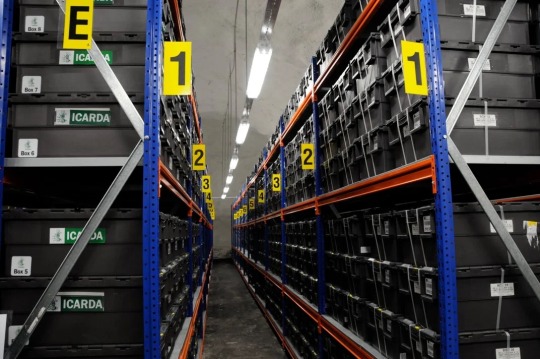
Shelves inside one of the seed vault's three chambers, each of which are capable of storing 3,000 samples. Mari Tefre/Global Crop Diversity Trust
“It is a bit like being in a cathedral. It has high ceilings and when you’re standing inside the mountain, there’s hardly any sound. All you can hear is yourself,” Lise Lykke Steffensen, executive director of NordGen, the gene bank of the Nordic countries that handles day-to-day operation of the vault, tells the Guardian’s Patrick Greenfield. “When you open the door, it’s minus 18 degrees Celsius—the international standard for conserving seeds—which is very, very cold. Then you see all of the boxes with seeds from all of these countries. I’ve been so many times and I’m still curious.”
Since its establishment in 2008, the vault’s collection has continued to grow. It is the largest global security reserve of seeds for food and feed crops, according to the Norwegian government.
In a tumultuous world where wars and extreme weather events wreak havoc, those who run the vault say it’s an important symbol of cooperation and global community.
“The seeds don’t care that there are North Korean seeds and South Korean seeds in the same aisle,” Brian Lainoff, the former lead partnerships coordinator of the Crop Trust, told Time’s Jennifer Duggan in 2017. “They are cold and safe up there, and that’s all that really matters.”
#The Svalbard Global Seed Vault#‘Doomsday’ Seed Vault#One Million Seed Samples#Arctic#Teresa Nowakowski#Norwegian 🇳🇴 Arctic
3 notes
·
View notes
Text

page 547 - seeds on the ground in a pile, no water to germinate them
#economics#economist#economy#the lorenz curve#lorenz#inequality#inequality gap#income distribution#income#living wage#wage#basic income#seeds#seed archive#end times#food grows from seeds#seed bank#svalbard#doomsday vault#doomsday vault norway#ai artificial intelligence#ai#artificial insemination
4 notes
·
View notes
Text
Two men who were instrumental in creating a global seed vault designed to safeguard the world's agricultural diversity will be honoured as the 2024 World Food Prize laureates.
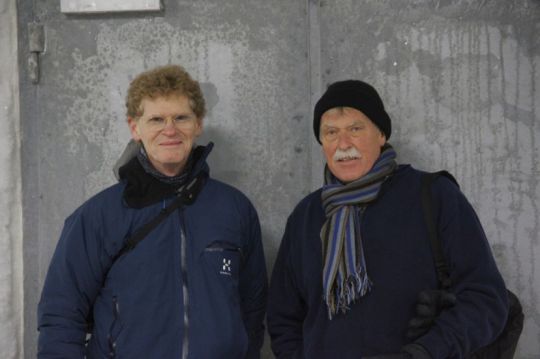
Cary Fowler, the US special envoy for Global Food Security, and Geoffrey Hawtin, an agricultural scientist from the UK and executive board member at the Global Crop Diversity Trust, will be awarded the annual prize and split a $500,000 (€464,000) award. In 2004, Fowler and Hawtin led the effort to build a backup vault of the world's crop seeds in a place where it could be safe from political upheaval and environmental changes.
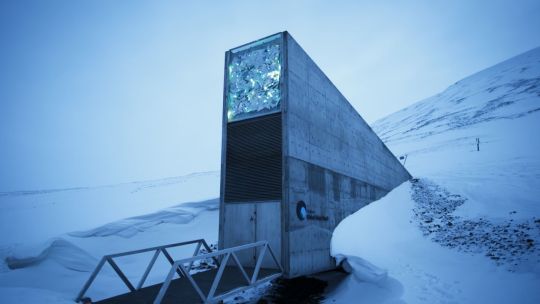
The facility was built into the side of a mountain on a Norwegian island in the Arctic Circle where temperatures could ensure seeds would be preserved.
The Svalbard Global Seed Vault - also known as the 'Doomsday vault' - opened in 2008 and now holds 1.25 million seed samples from nearly every country in the world.
#solarpunk#solar punk#indigenous knowledge#community#reculture#seed vault#svalbard#global food prize#preserving the future
154 notes
·
View notes
Text
12 notes
·
View notes
Text
Fourth Doctor - Project: Blue Box

TV stories
◆ Robot
◆ The Ark in Space
◆ The Sontaran Experiment
◆ Genesis of the Daleks
◆ Revenge of the Cybermen
◆ Terror of the Zygons
◆ Planet of Evil
◆ Pyramids of Mars
◆ The Android Invasion
◆ The Brain of Morbius
◆ The Seeds of Doom
◆ The Masque of the Mandragora
◆ The Hand of Fear
◆ The Deadly Assassin
◆ The Face of Evil
◆ The Robots of Death
◆ The Talons of Weng-Chiang
◆ Horror of Fang Rock
◆ The Invisible Enemy
◆ Image of the Fendahl
◆ The Sun Makers
◆ Underworld
◆ The Invasion of Time
◆ The Ribos Operation
◆ The Pirate Planet
◆ The Stones of Blood
◆ The Androids of Tara
◆ The Power of Kroll
◆ The Armageddon Factor
◆ Destiny of the Daleks
◆ City of Death
◆ The Creature from the Pit
◆ Nightmare of Eden
◆ The Horns of Nimon
◆ Shada
◆ The Leisure Hive
◆ Meglos
◆ Full Circle
◆ State of Decay
◆ Warrior’s Gate
◆ The Keeper of Traken
◆ Logopolis

Audio stories
- 4th Doctor Adventures & Audio Novels
◆ The Watchers
◆ Night of the Stormcrow
◆ Destination: Nerva
◆ The Renaissance Man
◆ The Wrath of the Iceni
◆ Energy of the Daleks
◆ Trail of the White Worm/The Oseidon Adventures
◆ The Auntie Matter
◆ The Sands of Life/War Against the Laan
◆ The Justice of Jalxar
◆ Phantoms of the Deep
◆ The Dalek Contract/The Final Phase
◆ The King of Sontar
◆ White Ghosts
◆ The Crooked Man
◆ The Evil One
◆ Last of the Colophon
◆ Destroy the Infinite
◆ The Abandoned
◆ Zygon Hunt
◆ The Exxilons
◆ The Darkness of Glass
◆ Requiem for the Rocket Men
◆ Death Match
◆ Suburban Hell
◆ The Cloisters of Terror
◆ The Fate of Krelos/Return to Telos
◆ Wave of Destruction
◆ The Labyrinth of Buda Castle
◆ The Paradox Planet/Legacy of Death
◆ Gallery of Ghouls
◆ The Trouble with Drax
◆ The Pursuit of History/Casualties of Time
◆ The Beast of Kravenos
◆ The Eternal Battle
◆ The Silent Scream
◆ Dethras
◆ The Haunting of Malkin Place
◆ Subterranea
◆ The Mavellan Grave
◆ The Skin of the Sleek/The Thief Who Stole Time
◆ The Sons of Kaldor
◆ The Crowmarsh Experiment
◆ The Mind Runners/The Demon Rises
◆ The Shadow of London
◆ The Bad Penny
◆ Kill the Doctor!/The Age of Sutekh
◆ The Sinestran Kill
◆ Planet of the Drashigs
◆ The Enchantress of Numbers
◆ The False Guardian/Time’s Assassin
◆ Fever Island
◆ The Perfect Prisoners
◆ Purgatory 12
◆ Chase the Night
◆ The Planet of the Witches
◆ The Quest of the Engineer
◆ Shadow of the Sun
◆ The World Traders
◆ The Day of the Comet
◆ The Tribulations of Thadeus Nook
◆ The Primeval Design
◆ Blood of the Time Lords
◆ The Ravencliff Witch
◆ The Dreams of Avarice
◆ Shellshock
◆ Peake Season
◆ Ice Heist
◆ Antilia the Lost
◆ The Wizard of Time
◆ The Friendly Invasion
◆ Stone Cold
◆ The Ghost of Margaret
◆ Storm of the Sea Devils
◆ World Beyond
◆ Matryoshka
◆ The Caged Assassin
◆ Metamorphosis
◆ The Face in the Storm
◆ Dominant Species
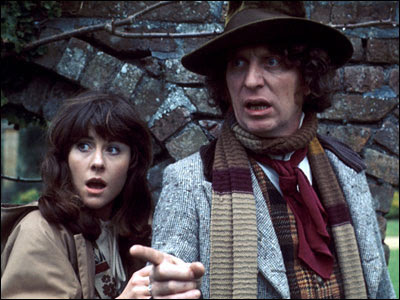
- The Companion Chronicles
◆ The Child
◆ The Catalyst
◆ Empathy Games
◆ The Time Vampire
◆ Ferril’s Folly
◆ Tales from the Vault
◆ The Stealers from Saiph
◆ The Beautiful People
◆ The Pyralis Effect
◆ Luna Romana
◆ The Invasion of E-Space
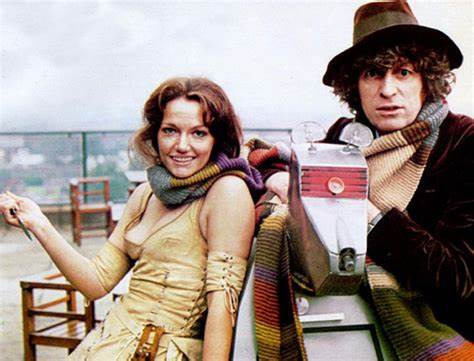
- The Lost Stories
◆ The Foe from the Future
◆ The Valley of Death
◆ The Doomsday Contract
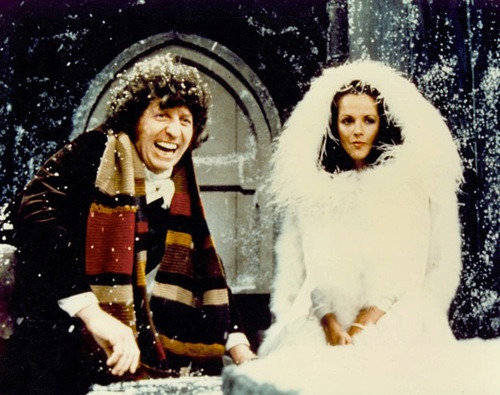
- Past Doctors, New Monsters
◆ Night of the Vashta Nerada

- Phillip Hinchcliffe Presents
◆ The Ghosts of Gralstead
◆ The Devil’s Armada
◆ The Genesis Chamber
◆ The Helm of Awe
◆ The God of Panthoms
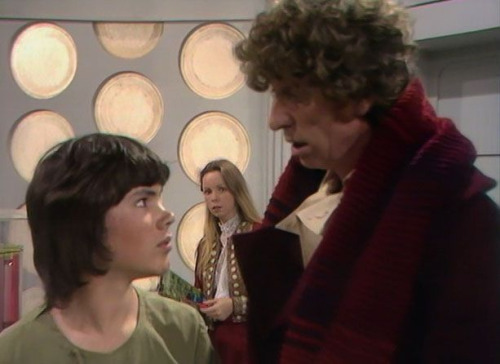
- Short Trips
◆ #HarrySullivan
◆ Collector’s Item
◆ The Wondrous Box
◆ How to Win Planets and Influence People
◆ Chain Reaction
◆ Only Connect
◆ Deleted Scenes
◆ The Revisionists
◆ Death-Dealer
◆ The Ghost Trap
◆ Black Dog
◆ The Beast of Muir
◆ Sound the Siren and I’ll Come To You Comrade
◆ The Smallest Bride
◆ String Theory
◆ I Am the Master
◆ The Warren Legacy
◆ The Doctor’s First XI
◆ The Old Rogue
◆ Breadcrumbs
◆ Waiting for Gadot
◆ A Full Life
◆ Messages from the Dead
◆ Erasure

Books
◆ The Romance of Crime
◆ System Shock
◆ Managra
◆ The English Way of Crime
◆ The Shadow of Weng-Chiang
◆ A Device of Death
◆ The Well-Mannered War
◆ Eye of Heaven
◆ Last Man Running
◆ Millenium Shock
◆ Corpse Maker
◆ Tomb of Valdemar
◆ Festival of Death
◆ Asylum
◆ Psi-ence
◆ Drift
◆ Wolfsbane
◆ Match of the Day
◆ The Drasten Curse
7 notes
·
View notes
Text
Another idea for a Joel fic for who might be interested:
Have you heard of the Global Seed Vaults in Norway? Ready for any kind of Doomsday, a sample of seeds from any kind of plant is kept safely in an icy cold environment. What if there were similar vaults in perhaps Canada and human kind has stopped cultivating many crops after 20 years of apocalypse. The Jackson community's crops suddenly run infertile/it's not enough to grow more and unless they want to starve next winter, they need people to travel North and get life providing seeds from these vaults and reader and Joel (maybe a fellowship that slowly dies one for one) volunteer. Meanwhile merging your dream of planting your garden and Joel herding sheep seems a possibility. What if you build that kind of future together?
#I thought it's sweet#joel miller#the last of us#tlou#fanfic#joel miller x reader#idea#fic idea#the last of us x reader#fanfiction#joel miller fanfiction#pedro pascal#reader
14 notes
·
View notes
Link
2 notes
·
View notes
Note
Oh, hey. One of the heist dialogues has Ana, Elsie, and Osiris talking about Nefele Stronghold.
Yes! Here.
Elsie: Submind fragment compiling...
Osiris: I have seen this term more than once in the data feed. What is "Nefele Stronghold"?
Ana: That again? Ikora's spies turned up that name around the same time Mars came back, but it was scrubbed from Rasputin's archives.
Elsie: I've never heard that name either, but "stronghold" designations were only used for colonization projects, or... anti-extinction vaults.
Osiris: This is promising. Perhaps additional clues await in the information we've already collected. Someone tell Saint I'll be in my study.
Really good confirmation that "strongholds" were about colonisation projects which ties into the whole story about Soteria from the dungeon and how she ended up crashing into Neptune, which directly confirms Neomuna's creation.
Obviously, Osiris and co don't have all the same details that we do right away, which is why Osiris is informing us that he has to go to his study immediately. Essentially without the knowledge we got from the dungeon, this would still be impossible to fully confirm and also impossible for the characters in-game to understand, but with these two combined, they'll figure it out in time for Lightfall.
It's not entirely clear what "anti-extinction vault" is. My first association is the Global Seed Vault (also dubbed "doomsday vault"), a real thing that exists:
The Seed Vault provides long-term storage of duplicates of seeds conserved in genebanks around the world. This provides security of the world's food supply against the loss of seeds in genebanks due to mismanagement, accident, equipment failures, funding cuts, war, sabotage, disease and natural disasters.
Basically, it's a vault that hosts seeds of various plants from all over the world which makes sure that, in the event of any disaster of any kind which threatens to destroy the environment, we have a backup of all plants needed for food production to re-seed the planet. It's located in the Arctic to make sure that the seeds remain safely stored in the event of a catastrophic power failure; the ice would then preserve the seeds naturally.
Given that we have this now, it's not a stretch to imagine that people would do the same in the Destiny universe, especially in the Golden Age. It's basically one of the first instincts really, to make sure our knowledge is preserved for the future, in case of a disaster. This is an absolutely fascinating concept to me and one that I would fully expect for Destiny to mention in some way; humanity in Destiny was already concerned with our longterm safety and envisioned a lot of different colonisation projects that tie directly with finding a place for humans to live in should the Solar system become uninhabitable for whatever reason.
This seems to be playing with that concept. I wonder if they plan on mentioning that again.
Some non-canon stuff from my obsession with this below:
The mention of anti-extinction vaults and what they could possibly mean is also really exciting to me because I've assumed their existence... in a Destiny tabletop RP I led almost 3 years ago!
I often talk about that one niche lore mention of how Antarctica is gone in the present day of Destiny and the presumed idea that the continent was sunk in the Collapse. Well, for my Destiny RP with my friends, I wanted to explore that. I needed a reason for my players being there in the Collapse, so, inspired by the Global Seed Vault, I envisioned a similar vault being buried in Antarctic ice, but much bigger in scope.
Mine was a Braytech facility and it did not just hold seeds, but a record of all life and knowledge on Earth; genetic material of animals, seeds from plants, archives and libraries. I also connected the work of the vault to the Exodus program and had the vault equipping Exodus ships with packages of Earth life and knowledge for colonists to take into their new worlds.
My reasoning for Darkness going out of their way to completely erase the entire continent off the face of the planet is that they wanted to make sure all of our history dies with us. It knew what we had hidden there and it knew that the destruction had to be thorough.
It was a cool RP! Everybody died!
The graphics I made for the players:
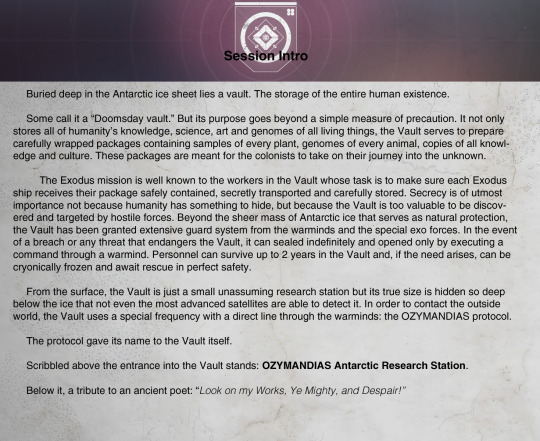
IMAGINE MY SURPRISE when Beyond Light came out 9 months after this and the missing pages from Clovis' logbook had the following:
I cannot believe that I actually find it tiring, but the sheer scale and passivity of the Vex constructs infuriates me.
Imagine stumbling upon an inscription in the desert: "I am Ozymandias, king of kings. Look upon my works. Or don't. I really don't care."
I think I also similarly lost my shit when I heard this line about anti-extinction vaults in the game. There is still time for Bungie to completely confirm a thing I invented 3 years ago as canon. This is how me getting more content about Antarctica being sank by Darkness can still win.
21 notes
·
View notes
Text
So I've been mulling over some thoughts regarding Borderlands and the arc villain Handsome Jack. Specifically, how the third game - an interquel between the first and second games - introduces this moral ambiguity to the character and tries to flip the script by having the character go through something big and become the larger-than-life persona that he is in Borderlands 2.
My understanding is that when the game came out - which, granted, will be nine years ago later this year - this sparked furious debate about whether [X] character/s are actually responsible for the awful state of the world in Borderlands 2, if Jack would have become that massive villain in the first place had the events of the Pre-Sequel not happened etc.
And the thing is, I get that people are going to find the moral ambiguity and that omnipresent "what-if" situation much more engaging on a personal level, especially in fandom. Fandom, in my experience, tends to be a place where people band together into camps and feed the theories and outstanding elements that they like the most about the work. That's cool, and I don't mean to trample on anyone's passion or make an incendiary call-to-arms going to war with dissenting opinions or whatever. I'm not a fandom guy any more. That's not my bag.
But I do want to share my personal opinions on this whole moral ambiguity angle that the Pre-Sequel introduced to Handsome Jack after the fact that may read like a club to the back of the head. That opinion being that I'm personally not a big fan of the idea of "ooh moral quandary ahh hidden depths ohhhh if only things were a little different" in regards to Handsome Jack, and I don't really buy it from Borderlands as a whole.
I think Jack was a ticking time bomb, and even if the events of the Pre-Sequel sped things up significantly, Jack would have been just as evil in the long run because of his blatant egoism, his disinterest in the well-being of others in service of his own wants and goals, and his incendiary and impotent rage that he directs at others for not receiving the respect and power he clearly wants. And I think it's a more interesting take for a franchise like Borderlands to go down that "what-if" rabbit hole, and come out the other side saying "yeah he would have been a piece of shit either way".
---
I'm going to keep this as spoiler-free as possible.
First of all, he has a history of self-serving and narcissistic behavior spanning years before the supposed "fallen hero" arc he goes through in the Pre-Sequel. Even before the PS Vault Hunters meet him, he's guilty of false imprisonment and forcing an innocent person to commit unethical acts under duress and against their will for most of their life. He built a death laser so he could nuke human settlements from orbit, entirely of his own accord. He harbors anger and resentment at those who have power over him - and granted, those people are pieces of shit to him and everyone around them, but Jack is no different in his dismissal of those "lower" than him and his willingness to sacrifice them for his grander, self-serving plans. The seeds are clearly already there despite his posturing of himself as the hero.
Secondly, his actions during the game. Are some of them necessary, if not the most kind? Sure. I love AI characters and I dislike the Skipper stuff that ends up happening, but I'm not gonna get hung up on that as "this makes Jack irredeemably evil". The thing with the scientists, at best, is a character being ruthless and taking the shortest possible route to the most desirable outcome. Those scenarios have been argued up and down, it's been done to death.
But I don't think you can really excuse the death laser he built to nuke bandit settlements from space, which he built using the remains of a biological doomsday weapon, without anyone's knowledge or input. And I think the general disdain he feels for those "under" him was always destined to end up manifesting in Jack blurring the line between "reasonable people trying to preserve their way of life" and "bandit scum who need to be wiped off the face of the planet".
---
When he ends up wanting more resources and power from Pandora and Elpis due to his ability to leverage his existing power to obtain it, and subsequently facing increasing resistance from the people whose lives he's ruining for his own self-centred "greater good", I think the end goal was always going to be Jack refusing to see them as human and wiping them out with a doomsday weapon as long as it gets him what he wants. That line between "person" and "bandit" was always flexible, and it depended on whether people were useful for his ends or a hindrance to him.
In the Pre-Sequel, you see what happens when Jack decides his greater good is worth more than the lives of those beneath him - where his supposed heroism is still the focus of his character. I didn't get hung up on Skipper or the scientists earlier, but even without bringing the inherent good or evil of those acts into it, they're clear examples in a pattern of behaviour where their lives are forfeit to achieve Jack's needs.
This character trait of sacrificing the little guy for his own ends is emphasised in each of those events that underline Jack's supposed "start of darkness", but it's an innate part of his personality from the start, not the unfortunate downfall of a good man forced to make hard decisions. The aforementioned false imprisonment of a person and manipulation of their behavior under duress, which occurred over a decade before the Pre-Sequel, proves that this is a behavior that he repeats to prop himself up and get ahead - whether he consciously sees his behaviour as evil or not.
It isn't new, it isn't an issue caused by his betrayal, it's a pre-existing condition - and that selfishness and self-absorption is only further emphasised when he goes off the deep end. I genuinely believe that whether he was betrayed or not, those exaggerated negative aspects were always destined to manifest were he to gain the power he desperately wanted.
---
And as such, in my opinion, the people who betrayed him were right to try to kill him pre-emptively. I think the person who gave him a motive speech about how he deserved to die was right. Even if it backfired and turned him into the villain he was in Borderlands 2, I think they were right to try and nip it in the bud.
Now, before I get ahead of myself - I'm not saying that the betrayers have the moral high ground. This was an assassination attempt. A necessary one in my opinion, but incredibly underhanded and dirty of them and deserving of some consternation.
I do have one issue with that, though. With Pre-Sequel being the third Borderlands game, released after the second game but taking place before it, this particular moral quagmire feels kind of forced after the fact? Like we've had a game with those betrayer characters being a part of the resistance against Jack, and now ooh, here's the secret hidden story they didn't tell you where they were the bad guys and they made Jack who he is. That's not hacky at all.
But I can respect the angle they're going for regarding Jack, because I personally believe that despite the basic posturing they're doing to paint this "fallen hero" narrative, the actions of Jack before, during and after the Pre-Sequel all point towards him being the exact murderous, selfish bastard he becomes. The betrayers actively made the Borderlands universe worse by driving Jack off the deep end - they made him stronger by trying to nip him in the bud. But I maintain that their logic for trying to do so - that he's an egomaniacal narcissist who'd only abuse absolute power to his own twisted ends - is totally sound.
In the Pre-Sequel, you kill a kid's dad because you beat the kid in a moon buggy race and the dad fires on you for making his son cry. In the first Borderlands, you're literally an amoral bounty hunter mowing through mountains of corpses on a twisted treasure hunt. In Borderlands 2, you ruin lives multiple times and you shoot a person in the face because they asked you to. Borderlands characters aren't exactly fountains of morality in the first place, so I kind of resent the idea that Jack or the people who betrayed him have to be painted in an objectively "correct" light.
Jack is a power-hungry piece of shit who should have been put down before the events of Borderlands 2. The people who "created" the Handsome Jack you see in Borderlands 2 by attempting to do just that? They did so in an unscrupulous and messy way that betrays their later posturing as the Big Goods of the Borderlands universe. That being said, the actions you commit as them in Borderlands 1 are hardly anything to aspire to.
---
The Borderlands universe is ugly, dirty and gritty down to the last speck of sand. Trying to answer the question of "what-if" is a fool's errand in my opinion, because the answer tends to be the most pessimistic and depraved option available.
What if Jack hadn't been pushed too far in the Pre-Sequel? He would have become a power-hungry fascist anyway, and he would have had a death ray that's 10x as powerful as it ended up being. His disdain for people who get in his way - because they're opposing his will as "the good guy" - would have led to him dehumanising them and wiping them off the face of Pandora at his own discretion. He was always going to be that piece of shit from Borderlands 2.
Can the people who betrayed him really maintain their moral righteousness knowing that their actions created the exact threat that they had to eventually destroy in Borderlands 2? Perhaps not, but I don't blame them for trying to do what they did. They're hypocrites to some degree, absolutely - I kind of hate just how far they take one of the characters to tell you the truth, but that reflects poorly on their character now. I'm not going to tell you that [X] character did nothing wrong. Of course they did, both before and after what happened in the Pre-Sequel. You played Borderlands 1, you know just how dirty their hands got. The idea that they were idolized as heroes come BL2 was kind of a joke.
But what I believe most of all is that Jack was going to make his power-grab one way or the other, and all of Pandora would have suffered from that eventually. He was already manipulating the narrative to get his way before you ever knew who he was. The assassination attempt was, to some degree, justifiable. Its failure absolutely hastened Jack's descent into villainy, and was responsible for the events of Borderlands 2. To claim that one side or the other is the "correct" or "moral" choice is stupid; it's layers of shit all the way down.
You can decide which option is less shit, in your own opinion, but I think it's a mistake to turn this into "sides". The world of Borderlands is miserable and amoral. Jack is a narcissistic, evil piece of shit, and prominent enemies of his eventual villainy enabled that villainy in the first place. But it would have happened eventually, so there was literally no winning this that didn't end up with Jack dying in the Pre-Sequel - and even then, the corporate wars that rage in the background of the universe and the desolation, depravity and slow, eventual death knell of Pandora as a whole ensure that no-one, anywhere, ever gets a happy ending. No-one wins, ever.
---
So I hear people got so heated about this that Borderlands blogs has to ban asks about certain characters because of how controversial they were. Reading that was the impetus of this post, because I can't see how you see a nihilistic shithole game universe like Borderlands and start flaming people about who's responsible for the world being even worse.
It seems clear to me that everything was going to suck regardless of what happened. Like, did people woobify Jack and make it out like he could have become the hero he wanted to be if only things worked out better? Because everything from his backstory to his actions in PS before the betrayal spell out that he's an egomaniac with a superiority complex. Did people go "oh well Jack only did what he did in BL2 because they made him this way"? Because they didn't force him to imprison a character for most of their natural lifespan and commit unethical acts to prop up his ascent to power.
And hey, the framing device of the Pre-Sequel makes a solid case for the people who betrayed him being self-righteous hypocrites who are responsible for what happened as well, and that's equally as valid. Like I said, the Borderlands universe is a dirty, pessimistic place. But for their role in Jack's villany, I'm of the belief that at worst, they just sped up what was always going to happen to Jack.
[X] character, while a self-serving hypocrite, is no more liable for Jack's actions as Jack himself is, the same way Batman isn't wholly liable for the Joker stabbing a baby to death despite "creating" the Joker. There's more to a person than One Bad Day that leads to them stabbing a baby to death - they're responsible for their own actions, that's their own actions and aspirations manifesting an evil outcome. In Jack's case, there's abundantly more happening behind the scenes of his life that led to his evil than just being betrayed and left for dead. He was a piece of shit from day one.
Yeah, it's callous and awful that those characters tried to assassinate Jack. But to act as if it's all or nothing - that it was One Bad Day standing between a decent person, if not misguided, and a rampaging genocidal maniac - is absurd. At worst, they sped up what was already there. The characters were already murderers at that point. Everything is and was terrible, and no-one was getting out of it unscathed.
The idea that it has to be one way or the other is absurd, and that's what I really hate about media that tries to be clever by flipping the lens and going "oooh spooky who's the real bad guy?????", especially when it's after they've written the character as an abject piece of shit in prior media - like dude, no matter what, Jack was deservedly going to go to hell for everything he did. He is a villain, and he'd always been one. Making the "good guys" would-be murderers who drove him to the edge faster doesn't change that.
---
That's my take, and I don't intend to supplant anyone else's viewpoint or anything. Please, redeem Handsome Jack in your fan works or answer that "what-if" question in accordance with your own viewpoint and values.
The simple fact is that I'm just not much of a "redemption arc" guy. I'm gonna be a basic bitch and say that Avatar: The Last Airbender nailed the redemption arc in a way that most media before and since just hasn't been able to do, but I'm also going to go out on a limb and say that the more Star Wars media exists that rack up Darth Vader's body count, the less I really care for his redemption. Like damn Luke, go the way of the Return of the Jedi manga and cut his fucking head off!
I like revenge. I like when villains are villains for the most part, and I think it's hacky to double back on something bad and go "well ACTUALLY here's a bunch of OTHER shit that happened that CHANGES THE CONTEXT OF THEIR ACTIONS". That's my bias, and I especially dislike the whole hand-wringing "things are not what they initially seemed" approach like what happened in Borderlands: the Pre-Sequel.
Basically, take all of this as one person's opinion whether it lines up with your own point of view or not. Discussion and enquiry is welcome, as magnanimous or as spirited as you'd like, though I would discourage anon hate because frankly I wouldn't treat you that way even if I disagreed with your point of view.
You know that feeling when you feel like you have a horrible disease that's going to give you a heart attack and ruin the rest of your life, but then you take a massive dump and you feel better than you've felt in about a month? That's basically what writing this post has been for me. The poison has left my body and I can breathe again.
6 notes
·
View notes
Text

Svalbard Global Seed Vault
Inside this building is 13,000 years of agricultural history. Essentially a huge safety deposit box, holding the world’s largest collection of agricultural biodiversity. Opened in 2008.
“There are big and small doomsdays going on around the world every day. Genetic material is being lost all over the globe,” says Marie Haga, executive director of the Crop Trust.

2017 - But soaring temperatures in the Arctic at the end of the world’s hottest ever recorded year led to melting and heavy rain, when light snow should have been falling. The end of 2016 saw average temperatures over 7C above normal on Spitsbergen, pushing the permafrost above melting point. A lot of water went into the start of the tunnel and then it froze to ice, so it was like a glacier when you went in. The vault was supposed to operate without the help of humans, but now must be monitored 24 hours a day. The breach has questioned the ability of the vault to survive as a lifeline for humanity if catastrophe strikes.
The vault managers are now taking precautions, including major work to waterproof the 100m-long tunnel into the mountain and digging trenches into the mountainside to channel meltwater and rain away. They have also removed electrical equipment from the tunnel that produced some heat and installed pumps in the vault itself in case of a future flood.
“We have to find solutions. It is a big responsibility and we take it very seriously. We are doing this for the world.”
“This is supposed to last for eternity,” said Åsmund Asdal at the Nordic Genetic Resource Centre, which operates the seed vault.
2024 - Daniel Brooks co-author of A Darwinian Survival Guide uses the Seed Vault as an analogy for preparing for the coming years.
"The place where it is was chosen because it was thought that it was going to be cold forever, and everything would be fine, and you could store all these seeds now. And now all the area around it is melting, and this whole thing is in jeopardy. This is a really good example of letting engineers and physicists be in charge of the construction process, rather than biologists. Biologists understand that conditions never stay the same; engineers engineer things for, this is the way things are, this is the way things are always going to be. Physicists are always looking for some sort of general law of in perpetuity, and biologists are never under any illusions about this. Biologists understand that things are always going to change."
Me: I'm digesting information and I don't quite know yet how to talk about my thought feelings. Change to our biosphere is rolling in faster than these intelligent people thought it would. Wildfire in the Arctic circle! Extreme weather. Ice melt. Social instability.
source: Time source: Guardian source: MIT Press Reader
1 note
·
View note
Text
The Importance of Seed Banks: Safeguarding Our Agricultural Future
In an era where climate change, habitat loss, and over-exploitation of natural resources are pressing global issues, the role of seed banks has never been more critical. These repositories of plant genetic material serve as vital resources for agriculture, conservation, and research, ensuring the survival of plant species and the continued availability of food crops for future generations.
What is a Seed Bank?
A seed bank is a type of biorepository that stores seeds from various plant species. These seeds are collected, cataloged, and stored under controlled conditions to preserve their viability for long periods. Seed banks can range from small collections held by botanical gardens to large, international facilities such as the Svalbard Global Seed Vault, often referred to as the "Doomsday Vault."
The Role of Seed Banks in Agriculture
Agriculture relies heavily on a relatively small number of crops, making our food supply vulnerable to pests, diseases, and changing environmental conditions. Seed banks provide a genetic backup, offering a diverse array of plant varieties that can be used to breed new crops with desirable traits such as disease resistance, drought tolerance, and improved nutritional content.
For example, during the Green Revolution of the 20th century, plant breeders utilized the genetic diversity stored in seed banks to develop high-yielding varieties of wheat and rice, which significantly increased food production and alleviated hunger in many parts of the world.
Biodiversity Conservation
Seed banks also play a crucial role in conserving plant biodiversity. With habitat destruction and climate change threatening the survival of many plant species, seed banks act as a safeguard against extinction. By preserving seeds from wild and endangered plant species, these banks ensure that even if a species disappears from its natural habitat, its genetic material remains accessible for future restoration efforts.
Moreover, seed banks contribute to the preservation of traditional crop varieties, which are often replaced by modern hybrids in commercial agriculture. These traditional varieties, also known as heirloom or landrace seeds, are valuable for their unique characteristics and adaptability to local conditions. By maintaining these varieties, seed banks help preserve cultural heritage and agricultural diversity.
Supporting Research and Innovation
Seed banks are not just storage facilities; they are active centers of research and innovation. Scientists use the genetic material stored in seed banks to study plant traits, develop new crop varieties, and explore the potential of underutilized species. This research is essential for addressing the challenges posed by a growing global population, changing climates, and the need for sustainable agriculture.
For instance, researchers are exploring the potential of "forgotten crops" stored in seed banks—such as quinoa, millet, and amaranth—to diversify our food systems and reduce reliance on a few staple crops. These underutilized species often have unique nutritional profiles and are better adapted to challenging environmental conditions.
Challenges Facing Seed Banks
Despite their importance, seed banks face several challenges. Funding and resource limitations can hinder the ability to collect, store, and regenerate seeds, especially for small or regional seed banks. Additionally, maintaining seed viability over long periods requires careful management and regular monitoring, as seeds can lose their germination capacity over time.
Another challenge is ensuring that the genetic material stored in seed banks remains accessible to the global community. This includes addressing legal and ethical issues related to the ownership and sharing of genetic resources, as well as ensuring that indigenous communities and smallholder farmers benefit from the conservation efforts.
Conclusion
Seed banks are indispensable to the future of agriculture and biodiversity conservation. By preserving the genetic diversity of plants, they provide a safety net for our food supply, support the development of resilient crops, and contribute to the conservation of our planet's rich botanical heritage. As we face unprecedented environmental challenges, investing in and supporting seed banks will be crucial to securing a sustainable and food-secure future for generations to come.
Whether you're a farmer, researcher, or simply someone who cares about the environment, understanding and supporting the work of seed banks is an investment in our collective future.
1 note
·
View note
Text
As the Europeans convinced Afrikans to discard their Indigenous seeds,
— they already have a seed bank.
This seed bank is known as the Svalbard Seed Vault, located in the Arctic Ocean in Norway.
They call it the Doomsday Bank.
They have stored 2.5 billion seeds for 4.5 million crop varieties in that vault, including those they have stolen from Afrika.
The purpose of this seed bank is to mitigate food security in the event their seeds are wiped away by natural calamities or bio-engineered disasters.
Then, these seeds will be sold to us in exchange for gold or other minerals or natural resources.
They sell to us GMOs, herbicides, and inorganic fertilizers as they plant and store their Indigenous seeds in a secure seed vault tucked safely in the Arctic Ocean
If we don't wake up, it is we who will suffer, become slaves and be recolonized.
Wake up!
Resist this colonialism against our food sovereignty.
0 notes
Text
The Svalbard Global Seed Vault: A Beacon of Hope Under Threat
✓ Subscribed A Fortress for the Future The Svalbard Global Seed Vault, often referred to as the “doomsday vault,” was designed as an isolated safeguard against an uncertain future. Nestled beneath a hill on a remote cluster of islands deep within the Arctic Circle, north of Norway, its frozen vaults preserve the seeds of survival. However, this fortress of hope has been forced to crack open its…
0 notes
Text
"Doomsday Seed Vault" in The Arctic - Bill Gates, Rockefeller and The GMO Giants Know Something We Don't
https://www.bibliotecapleyades.net/ciencia/ciencia_industryweapons31.htm
0 notes
Text
Champions of Global Food Security: Dr. Geoffrey Hawtin and Dr. Cary Fowler

Dr. Geoffrey Hawtin and Dr. Cary Fowler have been recognised as the 2024 World Food Prize Laureates for their significant contributions to seed conservation and the promotion of crop biodiversity. Their pioneering work in establishing the Svalbard Global Seed Vault, an underground facility within the Arctic Circle, has solidified their roles as instrumental figures in safeguarding global food security.
Establishing the “Doomsday Vault”
The Svalbard Global Seed Vault, often called the “Doomsday Vault,” was inaugurated in 2008 and today protects 1.25 million seed samples from over 6,000 plant species. This vault serves as a crucial backup facility, preserving the genetic diversity essential for responding to potential crises such as pandemics and climate-related disasters. The vault’s establishment was largely driven by Dr. Fowler, who proposed the idea during his tenure at CGIAR, leading to his role as the first Chair of the Vault’s International Advisory Council.
Read More:(https://theleadersglobe.com/life-interest/food/champions-of-global-food-security-dr-geoffrey-hawtin-and-dr-cary-fowler/)
#Global Food Security#Cary Fowler#Geoffrey Hawtin#biodiversity#global leader magazine#the leaders globe magazine#leadership magazine#world's leader magazine#article#best publication in the world#news#magazine#business
0 notes